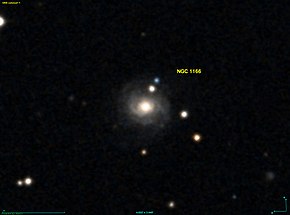This is an old revision of this page, as edited by S-Aura (talk | contribs) at 16:57, 23 December 2024 (Creating article of NGC 1166). The present address (URL) is a permanent link to this revision, which may differ significantly from the current revision.
Revision as of 16:57, 23 December 2024 by S-Aura (talk | contribs) (Creating article of NGC 1166)(diff) ← Previous revision | Latest revision (diff) | Newer revision → (diff)| NGC 1166 | |
|---|---|
 NGC 1166 (Hubble Space Telescope) NGC 1166 (Hubble Space Telescope) | |
| Observation data (J2000.0 epoch) | |
| Constellation | Eridanus |
| Right ascension | 03 02 32.40 |
| Declination | −12° 27′ 54.0″ |
| Redshift | 0.011765 |
| Heliocentric radial velocity | 3530 ± 20 km/s |
| Distance | 53 Mly |
| Apparent magnitude (V) | 11.70 |
| Apparent magnitude (B) | 12.30 |
| Characteristics | |
| Type | Sb |
| Apparent size (V) | 2.0 x 1.8 |
| Other designations | |
| PGC 11324, MCG -02-08-034, UGC 2437 | |
NGC 1166 is a barred spiral galaxy located in the constellation Eridanus. It is situated approximately 53 million light-years away from Earth and was discovered by the British astronomer John Herschel on November 17, 1834.
Structure and Characteristics
NGC 1166 is classified as an Sb-type barred spiral galaxy. This means the galaxy has a well-defined bar at its center, with spiral arms extending outward. It is a relatively medium-sized galaxy, spanning approximately 2.0 x 1.8 arcminutes in the sky. The galaxy exhibits active star formation in its spiral arms, where new stars are being created from interstellar gas and dust.
NGC 1166 also has a high surface brightness, making it an interesting target for both optical and infrared studies.
Discovery
NGC 1166 was discovered by the renowned astronomer John Herschel during his survey of the southern skies in 1834. Herschel's extensive cataloging of nebulae and galaxies led to the inclusion of NGC 1166 in the New General Catalogue (NGC), where it is listed among other deep-sky objects.
Location and Distance
NGC 1166 is located in the constellation Eridanus, a large and prominent southern constellation. The galaxy is about 53 million light-years away from Earth, with a radial velocity of approximately 3530 km/s, indicating its motion relative to the Milky Way.
Importance and Research
NGC 1166 is a useful object of study for astronomers researching the formation and evolution of barred spiral galaxies. Its relatively close proximity allows for detailed observation, and its active star-forming regions provide insights into the processes that drive galaxy evolution.
See Also
References
- ^ NASA/IPAC Extragalactic Database
- "NGC 1166". NASA/IPAC Extragalactic Database. Retrieved 2024-12-22.